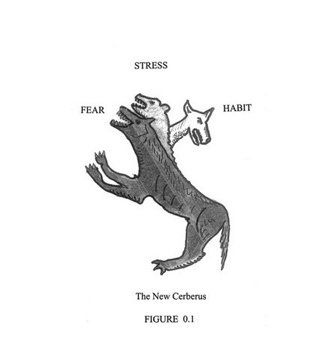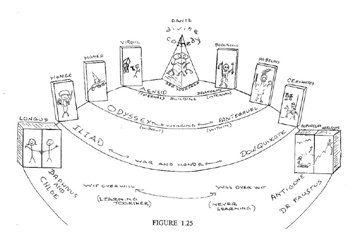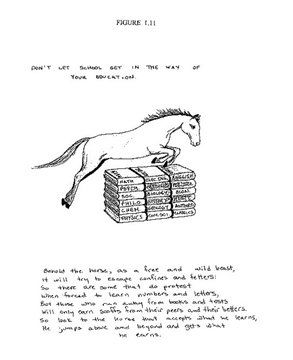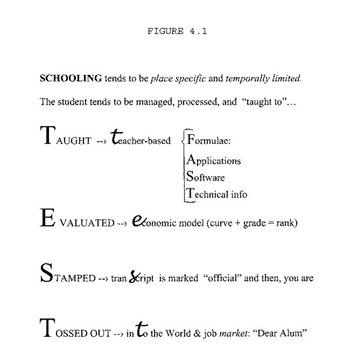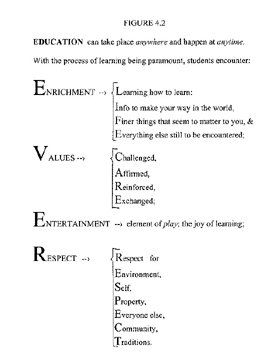EDUCATION & ANARCHY
REVIEWS:
"Stressing how educators can participate deliberately and reflectively in the process by which they let learning happen, Education & Anarchy
expands ways of thinking about teaching and learning. ...Recommended for pre- and in-service teachers." —Choice
40.1 (2002)
"Using examples ranging from Faulkner to Plato to the sport of fencing, Engel traverses a wide range of educational settings, from college classrooms to grade school to continuing education, as he encourages teachers and administrators to understand ways in which chaos can be an ally in 'letting learning happen.'" —Trinity Reporter
(Fall 2002)
"[Engel] shares his passion and devotion to teaching. ...The strength of this work is that he presents several projects and assignments that he has developed for his literature students with apparently positive results. Those who read the book may directly borrow or be inspired by them." —Sixteenth Century Journal
(2002)
ENDORSEMENTS:
"William Engel is a gracious and inspiring guide and a charismatic teacher. His revolutionary system is solidly grounded in both deep and wide learning and strikingly successful classroom experience. His proposals are ingenious, vital, revelatory, and will be as exciting for the instructor as for the student." —Stephen Orgel, J. E. Reynolds Professor in Humanities, Stanford University
"In the current climate of educational reform, which is obsessed with more testing and vouchers, Dr. Engel provides a much-needed voice to the debate. Anarchy and education is really what the core of all good education reform should be about : student learning and teacher instruction." —Ken Simon, Middle Grades Coordinator, Minneapolis Public Schools
"Engel remains steadfast in his efforts to shake up the stale and staid, tried and true failings of traditional education. I'll take his 'anarchy' over the anachronisms of textbook education any day. Engel is more interested in the organic than the cosmetic." —Dave Winans, Fifth Grade Teacher, Gulf Stream School, FL
"...an important antidote to the seemingly irresistible craze for testing and standardization that is transforming education into a top-down mind-numbing enterprise." —Charles B. Schultz, Trinity College, Hartford, CT (emeritus)
"Education & Anarchy empowers students to learn in ways that make sense to them. When students work together on mnemonic games like the 'capers' Engel describes, the medium is part of the message; they realize learning can be creative, cooperative, and yes, enjoyable." —Cal Fuller, Theatre Director, Montgomery Bell Academy, Nashville, TN
SYNOPSIS:
This book sets in motion a way of approaching the chaos, which, whether we acknowledge it or not, characterizes our relationship to teaching and learning.
Chapter 1, "Classroom Capers," shows how the ancient Art of Memory, with its emphasis on personalized visualization techniques, can be adapted for contemporary classroom use.
Chapter 2, based on an NEH Summer Humanities Seminar, addresses how teachers can participate more deliberately in the process of "letting learning happen."
Chapter 3, primarily on art and aesthetics, sheds light on how words, reflective of traditionally linear approaches to learning, tend to determine the scope and nature of our engagement with education.
Chapter 4, while concerned initially with ethics in the context of Continuing Education programs, advocates working creatively with the limits of what can be taught.
Chapter 5, "The Sword of Truth," uses athletic instruction in general and fencing in particular as a metaphor for teaching to explore the extent to which a student needs a teacher to learn.
In the end: education is about letting learning happen, one student at a time. Despite pressures from above, teachers---of whatever rank and working in no matter what discipline or field of study--are the ultimate guardians of this truth.
EPIGRAPHS:
We are on our way to… "a revolution by due course of law." This is undoubtedly, … if we are still to live and grow, and this famous nation is not to stagnate and dwindle away on the one hand, or, on the other, to perish miserably in mere anarchy and confusion, … what we are on the way to. Great changes there must be, for a revolution cannot accomplish itself without great changes; yet order there must be, for without order a revolution cannot accomplish itself by due course of law. So whatever brings risk of tumult and disorder … our best self, or right reason, plainly enjoins us to set our faces against. — Matthew Arnold, Culture and Anarchy
(1869/1961: 444)
The power to think and the desire to rebel. These faculties, combining their progressive action in history, represent the essential factor, the negative power in the positive development of human animality, and create consequently all that constitutes humanity in man. — Three elements or, if you like, three fundamental principles constitute the essential conditions of all human development, collective or individual, in history: (1) human animality; (2) thought; and (3) rebellion. To the first properly corresponds social and private economy; to the second, science; to the third, liberty. — Mikhail Bakunin,
God and the State
(1871/1970: 9, 12)
Would life, with all its inevitable drudgery and sorrows, be worth living if, besides daily work, man could never obtain a single pleasure according to his individual tastes? … After bread has been secured, leisure is the supreme aim. … And as all men do not and cannot resemble one another (the variety of tastes and needs is the chief guarantee of human progress) there will always be, men and women whose desire will go beyond those of ordinary individuals in some particular direction. … Some like statues, some pictures. A particular individual has no other ambition than to possess a good piano, while another is pleased with an accordion. The tastes vary, but the artistic needs exist in all. … But as we must recognize that man has other needs besides food, and as the strength of anarchy lies precisely in that it understands all human faculties and all passions, and ignores none, we shall, in a few words, explain how man can contrive to satisfy all his intellectual and artistic needs. —Peter Kropotkin,
Conquest of Bread
(1892/1995: 94-96)
OUTLINE (at a glance):
1. Classroom Capers
1. Grounding
2. Five Main Types
1. tagging
2. memory grids
3. mind mapping
4. magic circles
5. speaking pictures
3. Moving On
2. Letting Learning Happen
1. Manifesto
2. Demonstration
1. plan of study
1st unit: macrocosm & microcosm
2nd unit: discovery of the self
3rd unit: the will to power
4th unit: world of words
2. motto, expectations, and key questions
3. Credo
3. Speaking of Teaching
4. What Can Be Taught
1. Preamble
2. Three Possibilities
1. literature and human values
2. educating the princes
3. books with Bill
3. Drawing the Line
5. The Sword of Truth
1. Introduction
2. The Way of the Sword
1. salute
2. on guard
3. preparations
1. body movements
2. blade actions
4. offensive
1. attacks
2. ripostes
3. varied offensive
5. defensive
1. evasions
2. parries
6. counter-offensive
3. Lessons Learned from Fencing
Conclusion
CHAPTER ABSTRACTS:
Introduction
Whatever job description, array of tasks, or mission a teacher sees as primarily defining his or her role as an educator, one thread runs through them all: Teachers can turn a form of chaos into a kind of order. Every teacher's nightmare is losing control of the class. Until you become aware of the extent to which this understanding informs your approach to education, your day-to-day decisions in the classroom will remain reactive in nature. And yet, anarchy dances hand in hand with education if learning is destined to occur. No matter how much it may be feared, or the lengths to which people go to short-circuit it, anarchy remains a vital, if unspoken, component--and is perhaps the motivating factor--of lasting learning.
The overarching theme lending coherence to Education & Anarchy is revolution. Revolution need not be construed politically or socially, although it often is. Revolution also names the cycle of return in nature that characterizes everything from the motion of heavenly bodies to the work of seeds. Also woodland animals, for example, shed their pelts to make way for new and more lustrous coats appropriate to the oncoming season. So too the cases and conditions covered in this book concern how we go about, or resist, shedding what is no longer needed or useful. All of the signs around me indicate that the season for change in education is upon us once again.
Chapter 1: Classroom Capers
Visual memory cues and related mental triggering devices are as old as recorded history. Closer scrutiny of the main metaphors used to express such cues will help bring into focus the principles informing and animating an immemorial, if tacit, philosophy of education. This chapter traces the main contours of those principles and suggests that once they are recovered and judiciously adapted for contemporary classroom use, they can enable students to develop and cultivate luminous and often indelible points of connection to the material being studied. Specifically, five main types of mnemonic techniques are identified (Tagging, Memory Grids, Mind-Mapping, Magic Circles, and Speaking Pictures) and then used to illustrate the construction of study guides and learning aids, which collectively I call "capers." These capers are an integral part of students' portfolios and, taken together, chart visible stages in a student's on-going journey toward knowledge. Capers help students become more responsible for what they are learning, and thus become more cognizant of the aesthetic core of what they have learned and more reflective about how this learning took place.
Chapter 2: Letting Learning Happen
As in-service workshops and continuing education programs are fast becoming an indispensable part of the professional life of teachers today, we need to attend more closely to how we can "let learning happen." This chapter explores strategies that enable teachers once again to become students themselves in ways which honor their years of service and which respect their status as seasoned curriculum designers and effective classroom leaders. Some of the specific tactics used, while employed in the context of teaching intellectual history, are discussed with an eye toward encouraging you to contour them to fit your own prospective needs.
Chapter 3: Speaking of Teaching
The central chapter exposes the predominantly verbal way we come to terms with art; and, by extension, with other closely related domains of inquiry and endeavor, like philosophy and like education. While paying tribute to how this issue traditionally has been cast, this chapter critically examines the implied end of art as discussed by Martin Heidegger and John Dewey. Although their writings on the distinctions between the aesthetic experience and the work of art appear at roughly the same time, neither sought to engage the findings of the other. Despite this, and notwithstanding the overwhelming political rift between Germany and America in the 1930s, their influential conclusions about the power of art and education to affect social change are remarkably similar.
My approach thus affords an unlooked for glimpse into the possibility that the making of art is the happening of truth. To flesh this out further ? and to do so in a way that is consistent with, and disclosive of, the theme in question ? this chapter is extraordinarily careful in its precise use of words. Also, by using self-conscious repetition, this chapter seeks to turn the tables on a dominant (and predominating) view of pragmatic aesthetics that (1) focuses on products and measurable outcomes to validate and verify artistic activity, and (2) is superficial in its conception of truth as being causal, consequential, and essentially mimetic. Accordingly this chapter argues, in a way that intentionally sidetracks the train of thought traditionally associated with logical positivism and pragmatic aesthetics, that (1) process needs to be balanced into the equation of assessing the full and true value of the work of art, and (2) truth hides itself most elusively in the folds of fair approximations and faithful representations of whatever is put forward as being the standard which, we are told by experts and public opinion alike, we should be seeking to copy, reproduce, and imitate.
Chapter 4: What Can Be Taught
Continuing education programs and Internet based course-work have led to an extension and redefinition of the goals and needs of students. The resulting, more fluid, population of students has led educators to reconsider the limits of traditional instructional venues, as well as of what can be taught in the context of any prescribed course of study. It has also led to a general reassessment of how we go about delivering the material that is deemed important to be learned, irrespective of how this decision gets legislated and monitored. Even as we strive to keep abreast of these changes, we need to reflect on our roles as educators--especially our responsibilities to individual students.
Although the cases surveyed come primarily from my experiences as a provider of continuing legal education, in which works of literature are used to satisfy and to incite further the desire for life-long learning, this chapter raises broader questions that stem from a critical distinction between schooling and education. Many students look forward to continuing and, in some cases, finally enjoying their education only once they have left formal schooling. This chapter advocates that we work creatively with, and from within, the limits of what we think can be taught.
Chapter 5: The Sword of Truth
To what extent does a student need a teacher to learn how to learn? Athletics in general, and fencing in particular, give us a handy way to explore the ramifications of this question. With fencing, as with any discipline, once basic skills are covered, learning is enhanced by drill and application. Answers come swiftly through practical action, for only what works in the field counts. Still, aesthetic and ethical considerations ensure that interaction among fencers remains equitable and elegant. Fencing brings into focus what otherwise might remain outside our field of vision by showing us "in other words" what our role might be toward those we seek to educate.
Conclusion
The student comes first. What comes next is open for discussion. For example, what is to be taught, how to teach it, who should teach it, how to go about assessing what the students are expected to learn and who decides this. But however such issues are settled in the end, the student still needs to come first. In this book, as in my teaching, despite my tendency to revel in my own ingenuity, I have sought, every step of the way, to keep the needs of students foremost in mind.
Education is about students. It is not about programs, mandates, hiring policies, technology budgets, reform packages, or centers for teaching. Students come first. No matter how it might be justified, when students are seen as a means to accomplish this or that end, we lose sight of why teachers are there ? to teach. Of course programs must be developed, funded, and administered. Of course studies must be run to chart the relative success of this or that program. Of course funds must be raised to keep everything running. Of course teachers, faculty, and staff must be hired and fired, promoted and transferred, motivated and kept in line. But still, students should come first. If we are driven by anything else, then we are compromising what matters most in education.
Teachers have much to learn. Not only about the content of what they teach, but also about how they are going teach it, whether for the first or the fifth time. Each student provides you, the teacher, with opportunities to remember how you learn best, and to learn something from this. In this respect, teachers need to recognize they are students too. Education is about letting learning happen. And, more specifically, because the student comes first, education is about letting students learn. Despite pressure from above--or from within--teachers are the ultimate guardians of this truth.
SOME SAMPLE ILLUSTRATIONS:



